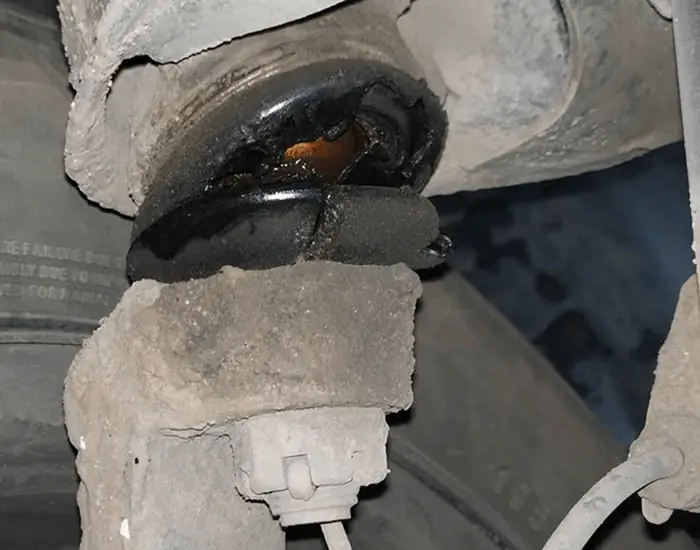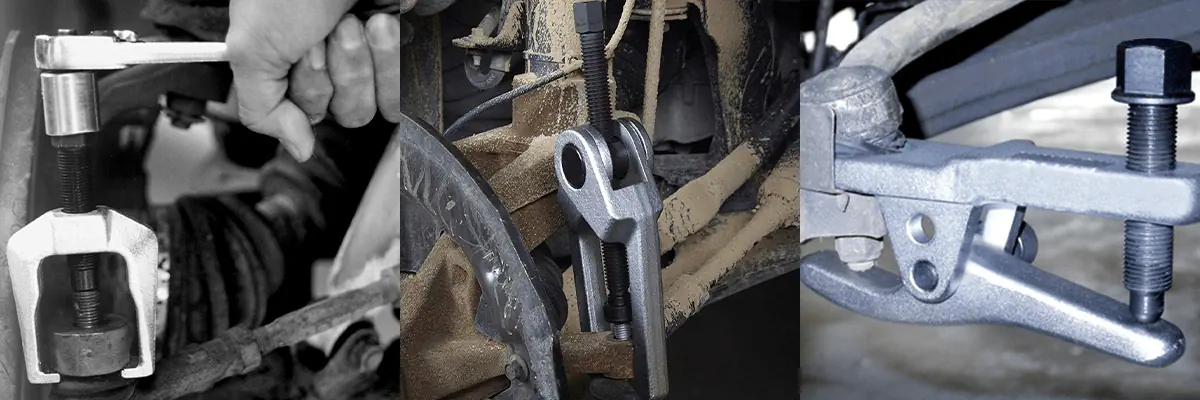Ball Joint FAQs
Symptoms, Replacement, Maintenance & More
1. What are ball joints?
Ball joints are key mechanical parts used for connection and support, which are mainly composed of spherical hinges and inner and outer cannulas. It can realize multi-direction relative motion between components, and is widely used in automobile suspension, steering system and engineering machinery and other fields.
2. What is the difference between upper and lower ball joints?
Upper ball joints attach to the upper control arm and mainly handle steering forces, keeping your wheels aligned precisely. Lower ball joints connect to the lower control arm and carry most of the vehicle’s weight while soaking up bumps from the road. Because they’re under so much more pressure, lower ball joints usually wear out faster than the upper ones.
3. What are the main applications of ball joints?
Common application areas include automobiles (cars, SUVs, trucks, etc.), construction machinery (excavators, loaders, etc.), agricultural machinery, and other equipment that requires flexible connection and rotation capabilities. These applications require high durability, precision and impact resistance.
4. What are the quality inspection standards for ball joints?
High-quality manufacturers have strict quality control systems and usually conduct production and testing in accordance with international standards and industry norms. Products are subjected to precision machining, durability testing, load testing and other tests to ensure that they meet strict quality requirements before they leave the factory.
5. How long do ball joints typically last?
Factory-installed ball joints usually last anywhere from 70,000 to 150,000 miles (110,000 to 240,000 km).The actual lifespan of a ball joint depends on driving conditions, road quality, vehicle load and maintenance frequency. Off-road or heavy-duty use will shorten its lifespan.
6. What causes ball joints to go bad?
When the protective rubber sleeve of the ball joint breaks or tears, and oil leaks, the ball joint will wear out. Dirt acts like sandpaper, causing rapid wear and corrosion inside the joint. Frequent driving on bumpy or rough roads, sharp turns or overloading of the vehicle will also bring additional pressure to them, leading to faster failure.

7. Can bad ball joints cause vibration while driving?
Yes. Worn ball joints can cause the wheel components to move excessively, resulting in significant vibration of the steering wheel during high-speed driving or turning. This “wobbling” phenomenon will worsen over time and may be mistaken for wheel imbalance.
8. How to tell if ball joints are bad?
There is an abnormal noise, the tires are worn unevenly, and the vehicle or the steering wheel vibrates abnormally. For details, please visit the symptoms of bad ball joint? page.
9. What happens if a ball joint breaks while driving??
A sudden failure of the ball joint could cause the control arm to separate from the steering knuckle, resulting in the loss of control of the wheels and severe steering deviation. In the worst-case scenario, the wheels might collapse or fall off, thereby causing a serious accident.
10. How to check if the ball joint is worn out?
Raise the vehicle and secure it with a jack. Hold the 12 o’clock and 6 o’clock positions of the tire and shake the tire back and forth; if there is excessive shaking, it indicates that the ball joint is worn. You can also use a crowbar under the control arm to check the vertical movement of the joint.
11. Can I replace ball joints myself?
If you have mechanical operation experience and the necessary tools, it is feasible to replace the ball joint yourself. However, considering safety and wheel alignment, it is usually advisable to have it installed by professionals.

12. What tools are needed to replace a ball joint?
Essential tools include:
- Ball joint press kit (C‑frame or screw‑type)
- Control arm removal tool or pickle fork
- Socket set and breaker bar
- Torque wrench for final tightness
- Hammer and pry bar for access
- Jack stands and vehicle jack
13. What grease should be used for ball joints?
Use NLGI #2 lithium‑based chassis grease for general applications. For heavy‑load or off‑road conditions, choose a molybdenum‑enhanced (moly) grease to improve wear resistance and reduce metal‑on‑metal friction.
14. Do ball joints need to be greased regularly?
If your ball joint has a grease fittings (zerks), lubricate it at every oil change or every 6,000 to 10,000 miles. Sealed units are pre-greased and do not require additional grease, but the boot should be inspected regularly for damage.
15. Are aftermarket ball joints as good as OEM??
High-quality after-sales ball joints from reputable suppliers can achieve or exceed the performance level of original factory products as long as they are manufactured according to the same specifications and materials. Please be sure to choose brands that have relevant test records and industry certifications to ensure their reliability.
16. Are MIVO ball joints compatible with Ford, Toyota, Honda?
Yes. MIVO designs its OEM‑grade ball joints to exact vehicle specifications for major manufacturers including Ford, Toyota, and Honda. Each ball joint is made to meet factory tolerances and fitment requirements for seamless replacement.
17. What is the typical delivery time for ball joints?
The delivery time depends on the order size and the degree of product customization. For standard series of products, many manufacturers can achieve fast shipping; For customized models, it is usually necessary to confirm detailed technical parameters with the customer and arrange production. Professional manufacturers will specify the delivery date in the contract to ensure the smooth progress of customers’ projects.
18. What after-sales service and technical support are available for ball joints?
MIVO ball joints manufacturers will provide perfect after-sales service and technical support:
- *Provide product installation instructions and maintenance manuals;
- *We have a special technical team to answer the questions in the use process;
- *Provide timely repair, replacement or technical upgrade services for product problems to ensure that customers have no worries.
19. How to choose a reliable ball joint manufacturer?
When choosing a manufacturer, focus on the following aspects:
- *Product quality and technical strength: understand the manufacturer’s production process, testing equipment and technical team background;
- *Product variety and customization ability: whether it can provide diversified products and customize according to needs;
- *Market reputation and certification qualification: whether it has international certification, long-term cooperation with customers and industry recognized quality assurance;
- *Delivery time and after-sales service: ensure the product can be delivered on time, and provide technical support after the sale.
20. What is the standard warranty period for ball joints?
The warranty period varies by manufacturer and specific product. Most quality ball joints products will provide clear warranty terms, generally covering the product itself manufacturing defects and faults in early use, the specific period is recommended to communicate with the supplier in detail at the time of purchase.
Still have some Questions ?
MIVO is here to answer your questions online. Looking for custom suspension or steering parts?